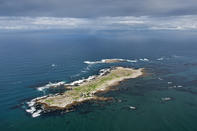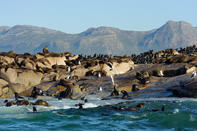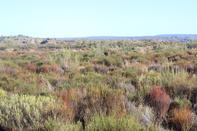Establishing an Island
To paraphrase the words of writer David Quammen: as far as species evolution and extinctions are concerned, continental islands start with everything and have everything to lose; ocean islands start with nothing and have everything to gain.

Madagascar began shearing away from Africa about 240 million years ago, but it clung to the rest of Gondwanaland's India, Australia and South America for another 150 million years until it finally split away about 90 million years ago to become the fourth largest island on the planet.
Like Noah's ark, it took with it a host of species, mostly dinosaurs, originating from the mainland but destined to become extinct with the rest of their kind 65 million years ago. The theory is that most modern vertebrates to inhabit the island must have migrated there after Gondwanaland fractured.
Small animals might have clung to 'rafts of vegetation', while others may have crossed the Mozambique Channel during times when sea levels dropped, travelling 'by land and sea along a chain of submerged highlands northwest of the island'.
Island Species

The plants or animals that find themselves on islands grow and mutate in isolation. For this reason, islands work a fantastical magic on the species they hold to their bosom. Wilson and his contemporary Robert MacArthur described the dynamic equilibrium of an island ecosystem in the late 1960s.
They argued that an island would reach a dynamic equilibrium, where its species diversity represented a balance between new species arriving and older inhabitants becoming extinct. As long as the factors driving arrival and departure stayed the same, the ecosystem should remain in equilibrium.
Distant islands have fewer species while closer islands have more species because of their higher likelihood of successfully crossing the deserts of salty water. The theory also argues that larger islands will have more species and lower extinction rates than smaller islands. Either way, all types of islands have simpler ecosystems than the mainland and, by extension, fewer mechanisms to counteract catastrophe.
Think of it as having a weaker immune system, purely because these islands have not been exposed to as wide a variety of diseases as they would be if they were connected to the mainland.
On a continent, a species might also be able to pack up and move more easily if the neighbourhood became too rough. On an island, it's not that simple, especially if, like the dodo, an animal has discarded air travel for the luxury of picking its livelihood from the forest floor.
Landlocked Islands

Technically speaking - in ecological terms - expanses of salty water are not the only geological features that can cause a piece of land to be isolated into an ecological island. Mountain peaks, rivers, differences in climate or soil can do much the same thing. This is where another kind of island is introduced - the landlocked one.
Leo Tolstoy remarked once what a strange illusion it is to assume that beauty is goodness. Tramping through renosterveld brings exactly this to mind, for it is the ugly step-sister to fynbos.
But renosterveld is by no means any less special and it is probably even more in need of conservation. This dull grey-green vegetation is dotted through the Cape like an archipelago of islands and one day its story will ring with the same tragedy as that of the dodos.
By Leonie Joubert